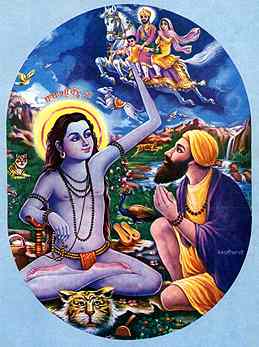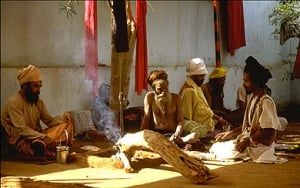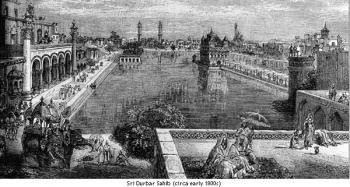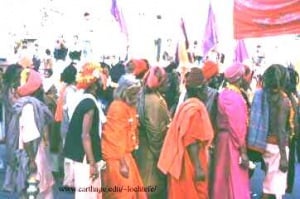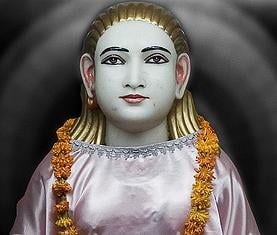Udasi
| The article contains information about Sects and cults which evolved during times of gurus or later, having influence of Sikhism. These sects have many different philosophies from Gurmat or were made to put down real essence of Gurmat. These sects were not formed by any Gurus or Bhagats. If you have any comments, please discuss them here |
Udasi or Udasin is a religious, ascetic sect, sampradaya (tradition) which considers itself as denomination of Sikhism, and focuses on the teachings of its founder, Sri Chand (1494-1643), son of Guru Nanak Dev, the founder and the first guru of Sikhism. Its Time of origin is 1494 (birth of Baba Siri Chand Maharaj), established as an institution in early 1600s.
The word 'Udasi' is derived from the Sanskrit word which means "one who is indifferent to or disregardful of worldly attachments, a stoic, or a mendicant." In Sikh tradition, the term udasi has also been used for each of the four preaching tours of Guru Nanak Sahib Ji; in this sense, udasi meant a prolonged absence from home. Some scholars, including many Udasis, trace the origin of the sect back to the Puraṇic age, but, historically speaking, Baba Sri Chand was the founder.
Udasis are a one of the puraatan sampradayas (traditional orders) of the Sikhs. It was founded in the sixteenth century by a son of Guru Nanak -- himself the founder of Sikhism -- called Shrichandra. The Udasin are therefore also known as Nanakputras, the 'sons of Nanak', and they revere the Grantha Saheb, the sacred book of the Sikhs.
History
Baba Sri Chand was a saintly person. It is said that his object in establishing the order of the Udasis was to propagate the teachings of his father. The Mantra, the sacred incantation or composition, attributed to the Udasi saint, Balu HaSria, records that Sri Chand received enlightenment from Guru Nanak, the perfect Guru, and that, after the passing away of the latter, he started his own sect. Sri Chand was a devoted Sikh and a saintly person. His object in establishing the order of the Udasis was to propagate the mission of his father. Baba Sri Chand stayed on amicable terms with the successors of Guru Nanak.
According to Kesar Siṅgh Chhibbar, he sent two turbans at the death of Guru Ram Das Ji in 1581, one for Prithi Chand, the eldest son of the fourth Guru, and another for Guru Arjan Dev Ji in recognition of his succession to the Guruship.
In 1629, Sri Chand asked Guru Hargobind to spare one of his sons to join him in his religious preaching. The Guru gave him Baba Gurditta, his eldest son. Baba Gurditta, although married, was disposed to saintly living. Before his death, Baba Sri Chand admitted Baba Gurditta to the Udasi order and appointed him his successor. Baba Gurditta appointed four head preachers Almast, Phul, Goind (or Gonda) and Balu Husria. He gave them his own dress which became the peculiar Udasi garb and smouldering embers from Baba Sri Chand`s dhum (sadhu`s hearth) to be taken to their new monastic seats.
These Udasi sadhus set up from those embers a new dhuan each at his seat and thus came into existence the four dhunns or hearths which became the active centres of Udasi preaching. Each dhuari came to be known after the name of its principal preacher.
Bakhshishan
Besides the four dhuans, there emerged another set of Udasi seats called bakhshishan, which flourished during the time of Guru Har Rai, Guru Tegh Bahadur and Guru Gobind Singh. A bakhshish (lit. bounty) was a missionary assignment conferred upon an individual by the Guru.
There were six prominent bakhshishan:
- Bhagat Bhagvanie (followers of Bhagat Bhagvan)
- SuthrashahJe ( followers of Suthrashah)
- Sangat Sahibie (followers of Sangat Sahib )
- Mihan Shahie or Mihan Dasie, so called after Mihan, the title conferred by Guru Tegh Bahadur on Ramdev
- Bakht Mallie ( followers of Bakht Mall)
- Jit Mallie (followers ofJIt Mall).
The saints of bakhshishes travelled widely and established their deras, sangats, maths and akharas in distant places throughout India.
However, after Guru Hargobind had allowed his eldest son, Baba Gurditta, to join Baba Sri Chand's sect, the Udasis began to receive support and guidance from the Gurus. Guru Hargobind`s successors conferred bakhshishes upon Udasi sadhus. Several of the Udasi saints are remembered with esteem in the Sikh tradition. For instance, the famous Bhagat Bhagvan Bhai Pheru of the Sangat Sahibia order, who had served in the langar or community kitchen in the time of Guru Har Rai, and Ramdev (later known as Mihan Sahib), who was originally a mashki or watercarrier in the service of Guru Tegh Bahadur from whom he had received (in recognition of his devoted service) the title of Mihan (bestower of rain) as well as the dress and marks of an Udasi consisting of selhi (woollen cord), topi" (cap), chola (hermit`s gown) and a nagara (drum).
Ramdev established his own order of the Udasis which came to be known as Mihan Dasie or Mihan Shahie.
Another notable Udasi sadhu was Mahant Kirpal who took part in the battle of Bhangani (1689) under Guru Gobind Singh. After the abolition of the order of the Masands by Guru Gobind Singh, the preaching of Guru Nanak`s word fell to the Udasis who also gradually took control of the Sikh places of worship. (Many Sikhs were Martyred in the early part of the 20th century when Sikh Sangats undertook regaining control of their Gurdwaras from men who had begun to consider the Gurdwaras and their attached lands as their personal property.)
Today, many modern Udasin worship panchayatana, a combination of five deities, namely Shiva, Vishnu, the Sun, goddess Durga, and Ganesh. Moreover they worship their founder-Guru Shrichandra. Their philosophy is basically the monistic Vedanta as set forth by Shankara, and in other respects as well they closely resemble the Shaiva sannyasis. Like all Shaiva sannyasis, the Udasin usually wear red or black cloth, apply ashes, have long hair in jata, and so on, but differ in details such as their woollen knitted caps and a small silver crescent ring in their right ear.
Udasis & Sikh Shrines
Generally, the Udasis proved zealous preachers of Sikh teachings and carried its message to the far corners of the country and beyond. They especially rediscovered places which had been sited by the Guru Sahibs and which had fallen into obscurity with the passage of time. They established on such spots their ḝeras and saṅgats and preached from Gurbaṇi. Thus the Udasi centres popularized the teachings of Guru Nanak Sahib Ji not only in the Punjab but also in far off places.
The Udasis preached the message of Gurū Nĝnak and revered and recited the bĝṇī of the Gurūs. Bĝbĝ Srī Chand did occasionally visit the Sikh Gurus who treated him with respect for being a saintly personage as well as for being a son of Guru Nanak Sahib Ji. A notable Udasi sadhu in Sikh history is Mahant Kirpal who took part in the Battle of Bhangani (1689) under Guru Gobind Singh Ji.
After the abolition of the order of the Masands by Guru Gobind Singh Ji, the preaching of Guru Nanak Sahib Ji’s word fell to the Udasis who also gradually took control of the Sikh places of worship. When Guru Gobind Siṅgh Ji evacuated the Fort of Sri Anandpur Sahib along with his Sikhs, an Udasi monk, Gurbakhsh Das, undertook the task to look after the local shrines such as Sis Ganj and Kesgaṛh Sahib. When after the death of Guru Gobind Siṅgh Ji, one Gulaab Rai, an impostor proclaimed himself guru at Anandpur Sahib and tried to take possession of the shrines, Gurbakhsh Das thwarted his scheme. Gurbakhsh Das successors continued to look after the Anandpur Sahib shrines till their management was stolen from them in recent times by modern "Singh Sabha/Tat Khlasa" Sikhs (a 19th century political movement)which went on to create the Shiromani Gurdwara Parbandhak Committee.
At Nanded where Guru Gobind Singh passed away, Mahant Ishar Das Udasi performed the services at Darbar Guru Gobind Singh (Hazur Sahib) and managed the shrine from 1765 Bk/AD 1708 to 1782 Bk/AD 1725. He was succeeded by his disciple Gopal Das Udasi, who remained in charge of Darbar Hazur Sahib up to 1803 Bk/ AD 1746. Gopal Das was succeeded by his disciple Saran Das Udasi, who served the shrine for a long period of 30 years. After Saran Das the control of the Darbar passed into the hands of the Sikhs who had, by that time, come from the Punjab in considerable numbers and settled at Nanded. In 1768 Bk/AD 1711 an Udasi sadhu, SANT Gopal Das, popularly known as Goddar Faquir, was appointed GRANTHI at the Harimandar at AMRITSAR by Bhai Mani Singh, sent to Amritsar as custodian of the shrine by Mata Sundari. Gopal Das was later replaced by another Udasi, Bhai Chahchal Singh, a pious and devoted Sikh. Udasis recruit their followers from all castes and professions.
During eighteenth century, the Udasis (not appearing as Khalsa Singhs) escaped the persecution of the Mughal rulers. Since they considered themselves as Sikhs, this naturally led them to look after the Sikh shrines in the absence of Khalsa Singhs and the Akalis/Nihangs (see separate entries). Here they performed a key role in keeping Sikh teaching alive. Anand Ghan, an Udasi scholar of the late 18th and early 19th centuries, wrote commentaries on the Adi Granth.
The Mahants (those in charge of the Gurdwaras) of the nineteenth and early twentieth century, frequently claimed an Udasi descent, though their life style had considerably changed.
When the Khalsa Singhs were involved in war against the Mughals, it was the Udasis that kept the Guru’s tradition alive by becoming custodians of the Gurdwaras.
Udasi & Sikhs
In their religious practices they differ from the mainstream Sikhs, though they revere Guru Nanak Sahib Ji and Guru Granth Sahib Ji like all other Sikhs. In their monasteries, Guru Granth Sahib Ji is the scripture that is read. However, after the SGPC acquired a monopoly on all Sikh places of worship, fewer deras keep Guru Granth Sahib installed there, fearing the Singh Sabha Sikhs could take over the management of the deras. They do not subscribe SGPC verison of the Rehat Maryada. Their ardaas also varies. Ringing of bells (ghaṇṭī or ghaṛīĝl), blowing instruments (narsingha or siṅghī) form part of their religious service. They worship idols of Guru Nanak Sahib Ji and Baba Sri Chand, a practice frowned upon by modern, mainstream SGPC Sikhs. Their salutations are Vaahguru (Glory of the God), Gajo Ji Vaahguru (Hail aloud the glorious Lord) or Alakh (Hail the Unknowable).
Today, having been pushed away from the majority Sikh panth by anti-hindu extremists, and corrupted Singh Sabha elites, many modern Udasis engage in pancadevopasana, the worship of a combination of five deities or the five qualified facets of the Brahman, namely Shiva, Vishnu, Surya, Durga, and [[Ganesh]. Amongst Udasis, some are celibate ascetics, others householders, some are jatadhari (dreadlocked) ash-covered Sadhus, and others have no distinctive appearance. Not only are they scholars of Sanskrit, their particularly adept in Ayurveda, the tradition Indian medicine.
The Udasis believe that after gaining matra one can attain param tattva (the highest truth) and achieve MUKTI (release). The term matra, lit. a measure or quantity, stands in prosody and grammar for the length of time required to pronounce a short vowel. But the term has acquired an extended meaning in the Udasi tradition, signifying an incantation or sacred text. An Udasi matra is the sacred formula addressed to the disciples. as counsel and advice. There are a considerable number of these matras attributed to Guru Nanak, Baba Sri Chand, Baba Gurditta, Almast and Balu HaSria. But the matras attributed to Sri Chand have special significance for the Udasis and are highly cherished by them.
Some of the Udasis wear white while others prefer gerūĝ (ochre) or red-coloured garments. Those belonging to the Nangĝ sect remain naked, wearing nothing except a brass chain around their waist, which is frowned upon by the modern, mainstream, Singh Sabha minded Sikhs of today. Some wear matted hair and apply ashes over their body. Some wear cord worn around the head, neck and waist. They abstain from alcohol, but some use bhang (hemp), charas. Some also practice celibacy. Their beliefs put them at odds the modern, mainstream interpretation of Gurmat. The Modern interpretation of Gurmat having distinctive anti-hindu, sectarian, and elitist mindset which was not present in the path prior to the late 19th century.
Besides disseminating the word of Guru Nanak Sahib Ji, Udasi centres serve as seminaries of Sikh learning. Chelĝs, i.e. disciples, gather around the head of the monastery who instructs them in Sikh and old classical texts. The heads of these centres traveled with their pupils to places of pilgrimage and participated in debate and discourse.
The Udasi buṅgĝs or rest houses around the Harimandar Sĝhib were among the prominent centres of learning. Udasi cloister at Amritsar, Brahm Būṭĝ Akhĝṛĝ, ran a Gurmukhi school which attracted a considerable number of pupils. Some Udasi centres also imparted training in Indian system of medicine and physiology. One such seat was the buṅgĝ of Paṇḝit Saroop Daas Udasi who was a great scholar as well as an authority on Charaka Samhitĝ, the famous treatise on Ayurveda.
The heads of these centres travelled with their pupils to places of pilgrimage and participated in debate and discourse. The Udasi bungas or rest houses around the Harimandar were among the prominent centres of learning. Udasi cloister at Amritsar, Brahm Buta Akhara, ran a GURMUKHI school which attracted a considerable number of pupils. Some Udasi centres also imparted training in Indian system of medicine and physiology. One such seat was the BUNGA of Pandit Sarup Das Udasi who was a great scholar as well as an authority on Charaka Samhita, the famous treatise on Ayurveda.
In the troubled years of the 18th century when many followers of the Gurus suffered severe persecution, the Udasi sadhus took charge of their places of worship. Their control of the holy shrines lasted until the opening decades of the twentieth century when political movements monopolized the control and management of Gurdwaras. The Udasis, where banished, ridiculed and forced to create their own deras and monasteries. The most important of their centres in the North are Brahm Buta Akhara and Sangalanvala Akhara at Amritsar, Niranjania Akhara at PATIALA and the Panchaiti Akhara at Haridvar.
Acc 2 udasis:‘Guru Granth is such a great philosophy greater than all. He who has read Guru Granth Sahib sees in it come all the reading of Vedas. How is this?‘ Reading reading we load carts [With books]’ [quote from Adi Guru Granth] So how many Hindu religious texts are we to read? For this reason we preached to all that in this [Adi Guru Granth] are all philosophies. The thinking of all religions is in this. Ramayana is in it,‘Ram Ram keep near you’ [quote from Adi Guru Granth], This is written there. For this reason all the Shashters [Hindu spiritual texts] also come in it. That is why all our traditions [Sikh] acknowledge it [as Guru].’
‘Maharaj [Baba Sri Chand] preaching of Guru Granth that the Udasis have done in India all over. In all places, history shows, using Gutkas [small Sikh prayer books] we spread. We taught all to read Sikh scriptures. This is the gift of the holy men, the Udhasis. They [S.G.P.C. Akali Dal political Party, Singh Sabhas, etc] cannot even in seven lifetimes preach as much as the Udhasis and Nirmalas have done and are still doing now. Even now, whenever we preach we always without exception include teachings from [Adi] Guru Granth Sahib. We give examples [from Sikh history] of how you should follow the footsteps of the Gurus. Then your suffering shall be removed. Only then can your thinking and mind can come pure. That is if you desire Oh Brother, otherwise, it is up to you.’ by Baba Gobind Das,
Udasis during Banda Bahadur Regin
The Udasis show respect to the Vedas, Puranas, Shastras as well as the Guru Granth Sahib, which many view as the 5th Veda (SriVed). Throughout the time of Maharaja Ranjit Singh's empire, and up to the time of the British Raj, there was largely no difference between what modern people understand today as "Sikhs" or "Hindus." Instead, you had varying paths and orders which reflected a wide variety of Gurbani interpretations. You had "Sikhs" who practiced an ascetic lifestyle (Udasis, and to a certain extant Akali Nihangs and Nirmalas) you had "Sikhs" who practiced martial arts and continued the martial tradition of the Guru's (Akali Nihangs), you had scholars and those who focused on learning (Nirmalas) and you had those who focused primarily on providing humanitarian ad (Sevapanthis) you also had the layity who had no particular allegiance to any one group and simply considered themselves a follower of Guru Nanak (Nanakpanthis). The idea of "Sikhs" as a distinct and separate group with universal identity was put forward by political groups such as the Tat Khalsa/Singh Sabha movement. The goal of these movements was to instigate separation from the majority population and craft a unified distinct identity, free from everything that resembled their interpretation of "Hinduism" which, as a concept, did not exist in South Asia until the time of the British Raj. The modern idea of "Sikhs" being separate from "Hindus", or the idea that Sikhs constituted a single homogeneous group which was antithetical to "Hinduism" are not representative of how traditional practitioners of the Sikh tradition thought, acted, or behaved. Traditionally, a "Hindu" was not a religious classification, but was a secular and racial classification much like Pathani, or Turk, or Englishman. The broad umbrella term for South Asian religions being Sanatan Dharma, with many different philosophies, teachings, gurus, and religious books. Traditionally, if one was inquiring into the religious preference of a Hindu of that time, you might receive an answer something like, "I am a devotee of such and such guru, of such and such sampradaya." which could be broadly categorized as being within the Vaishnava, Shavia, Shakta, Smarta, Shrauta, Buddhist, Yoga, Tantra, Natha schools of thought. Sikhs, or Nanakpanthis being just another tradition among many, distinct, but not necessarily separate. Today, do to a complex array reasons varying from British colonialism, the rise of Hindutva groups like Arya Samaj, Punjabi anti-Hindu political groups, The events of Operation Bluestar, and many other phenomenon, there is a wide divide between what is considered to be "Hinduism" and "Sikhism," both terms being non existant in traditional Dharmic thought. As such, the Udasis have been one group among many (Akali Nihangs, SevaPanthis, Nirmalas, etc) which have been caught in between this political struggle, and have been shunned and frowned upon by what has become the accepted mainstream religion we now know as "Sikhism."
Symbols
No distinct restrictions on hair; some wore it long and matted, others short. The matted hair symbolises their renunciation of worldly life. To this extent many go around naked and smear ash on their bodies, again symbolising their death to the world of family relations business and caste.
Adherents
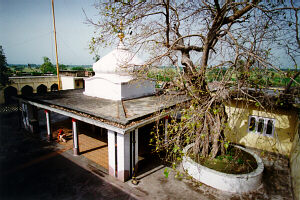
Its adherents not only revere Sri Guru Granth Sahib, but have in their treasure-house of sacred texts, Sanskritic scriptures such as the Veda, the Shastras, the Puranas, the Itihasas viz. the Ramayana and the Mahabharata, etc., along with works associated with the Gurus. To Udasis, also known as Nanak-putras (sons of Nanak), Guru Nanak Dev Ji is none other than the avatar of Sri Vishnu, and Baba Sri Chand Ji of Bhagavan Shiva. While the purpose of both was to protect the sanatan or eternal Dharma (moral and cosmic Order), the particular mission of Baba Ji was to spread the message of his Guru and father, Nirankar-svarup (the form of the Formless) Jagadguru Nanak Dev Ji. Thus, in the spirit of their founder, the scholarly Udasis were the missionaries of Gurmat. .There were more than a dozen orders at the end of Sikh Rule in 1849. The number of establishments rose dramatically from the 1790s to the 1840s. They had more than 250 centres (akharas) spread across the Panjab and even beyond. In the 1891 Census 10,518 Hindus and 1,165 Sikhs returned themselves as 'Udasis'. (Census of India, 1891, Vol.XX and Vol.XXI, The Punjab and its Feudatories, by E.D. Maclagan, Part II and III, Calcutta, 1892, pp.826-9 and pp.572-3.) However, there are no official contemporary numbers, (see also the note at the end of the Explanatory Introduction).
Headquarters/Main Centre
There were four Udasi centres (akharas or dhuans) each controlling certain preaching areas. These were eastern India (with the main centre at Nanakmata), western Panjab and Kashmir, Malwa and Doaba.
Given some of the beliefs and practices above, one may wonder who the Udasis are and whether they are confused. There are three possibilities of explanation:
- either they do not know whether they follow ‘Hinduism’ or ‘Sikhism’, or
- they have taken parts of both, or
- it is in fact the world who is mistakenly confused by seeing things in black and white and it is the Udasis who, amongst other legitimate sampradayas going back to the Gurus, truly follow and understand the teachings of the Great Sovereign Masters. It is not they who have problems of identity, but everyone else.
Their reality depicts a diminishing truth, while the rest of the modernist world has been unknowingly duped into the duality of these two artificial and until recently, non-existent religious categories viz. ‘Hinduism’ and ‘Sikhism’ created by British Colonialists. This is not how it used to be. After all the suffix ism which is the crux of our problem of understanding the truth as it stood before the time of the Raj, conceptually and linguistically belongs to the Western world, and is alien to the traditional Indian mind. To understand the reality of religiosity before the intellectual impact of the British Raj in Panjab, and thus the world of the Udasis and other puratan (ancient) traditions, one must understand it from its own perspective, not from the foreign concepts and categories of western thought.
Brahmboota Akharha
Brahmboota Akhara' (encampment/temple) is one of several located in and around Amritsar, Punjab, where Udasis (traditional pacifist Sikh missionaries) once resided in their masses, and propagated 'Dharam' (universal concept of righteousness) to all people regardless of colour, creed and socio-economic background.
The temple is situated behind 'Harimandir Sahib' (more commonly known as the Golden Temple). It derives its name from 'Brahmboota' (literally meaning 'root of wisdom/knowledge') from the tale of Srimaan 108 Mahant Pritam Das Ji Maharaj, who travelled by foot to 68 'Tirath' (centres of pilgrimage mentioned within both Hindu and Sikh sacred scriptures) throughout Indian subcontinent.
He carried with him a 'boota' (small plant) in a pitcher, which he watered using water at wells located at each of these 68 centres of worship. He then brought the 'boota' back to Amritsar, and planted it. The tree became known as 'Brahmboota', hence the name of the 'Akhara'.
Sadly, during the political unrest in the late 1970s, followers of various post-British Raj modern Sikh institutions such as the S.G.P.C cut down this tree. They also destroyed various sections of the 'Akhara' in order to remove the influence of the pacifist Udasi traditions deeming them to be too 'Hindu'.
This particular idol of Baba Sri Chand Ji Maharaj is considered to be one of the oldest in existance within the Udasi world.
References
- Randhir Singh, Bhai, Udasi Siklian di Vithiya. Amritsar, 1959
- Nara, Ishar Singh, ItihasBaba Sri ChandJI Sahib ate Udasin Sampardai. Amritsar, 1975
- Macauliffe, Max Arthur, The Sikh Religion : Its Gurus, Sacred Writings and Authors. Oxford, 1909
See Also
External Links
| Sects & Cults |
|
♣♣ Ad Dharm ♣♣ Akalis ♣♣ Bandai Sikhs ♣♣ Balmiki ♣♣ Bhatra ♣♣ Brindaban Matt ♣♣ Daya Singh Samparda ♣♣ Dhir Malias ♣♣ Handalis ♣♣ Kabir Panthi ♣♣ Kirtan jatha Group ♣♣ Kooka ♣♣ Kutta Marg ♣♣ Majhabi ♣♣ Manjis ♣♣ Masand ♣♣ Merhbanieh ♣♣ Mihan Sahibs ♣♣ Minas ♣♣ Nirankari ♣♣ Nanak panthi ♣♣ Nanakpanthi Sindhis ♣♣ Namdev Panthi ♣♣ Namdhari ♣♣ Nanaksaria ♣♣ Nihang ♣♣ Nikalsaini ♣♣ Niranjaniye ♣♣ Nirmala ♣♣ Panch Khalsa Diwan ♣♣ Parsadi Sikhs ♣♣ Phul Sahib dhuan ♣♣ Radha Swami ♣♣ Ram Raiyas ♣♣ Ravidasi ♣♣ Ridváni Sikhs ♣♣ Suthra Shahi ♣♣ Sewapanthi ♣♣ Sat kartaria ♣♣ Sant Nirankaris ♣♣ Sanwal Shahis ♣♣ Sanatan Singh Sabhais ♣♣ Sachkhand Nanak Dhaam ♣♣ Samparda Bhindra ♣♣ Tat Khalsa ♣♣ Sikligars ♣♣ Pachhada Jats ♣♣ Satnami's ♣♣ Udasi Sikhs ♣♣ |
